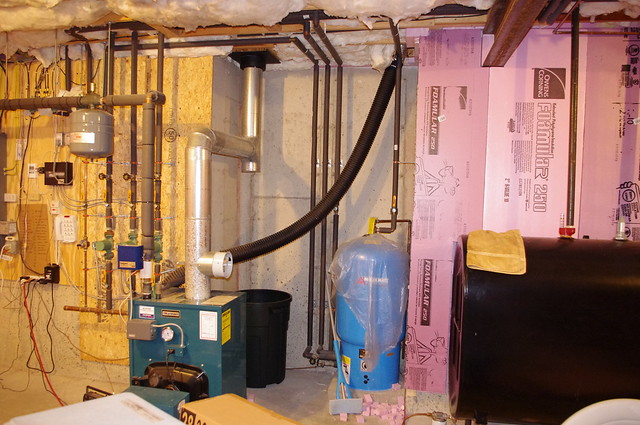Velvetfoot,
Now that your more comfortable with some of the control issues, it's time to discuss multi-boiler plumbing. As a starting point, please read my previous post to Katman, as I try to discuss some of the pros/cons of the various multi-boiler designs and the benefits of my proposed design point for your Hydroflex solution (Which will be just like my installation). Basically, we want Hot Water right at the consuming zone without ever losing any of the heat in the unused boiler.
Yes, In your case the 3/4" Hydroflex connections make a series design very undesirable for flow reasons !
I have some important comments on the Hydroflex 3/4" connections :
1) As I learned the hardway, part of the Multi-Boiler problem is meeting and matching flow rates for all of the various flow situations (Oil vs Pellet operation, with 1 zone running, 2 zones running, DHW going etc...).
- Can you confirm that you can setup "Priority" for your DHW zone ? (I think this is a requirement for Hydroflex because of the limited BTU capability)
- Can you tell me what circulators you are using (Taco 007 ?) ?
- What Diameter pipe for the Heating Zones (3/4") ?
- What Diameter pipe for the DHW Zone (1") ?
2) For the Hydroflex, I highly recommend you use 1" piping to maximize flow on your Pellet Primary Loop ! Use 3/4" to 1" fittings right at the Hydroflex Boiler connections and then plumb your new pellet loop (with Air-Scoop, Expansion Tank, etc...) using 1" pipe to your 1-1/2" manifolds. This will allow maximum flow and BTU extraction from the Hydroflex Boiler and the 1" pipe can handle Qty=2Zones of 3/4" pipes worth of water volume ! Use 1-1/2" piping for any changes on your existing 1-1/2" Header pipes ! Flow rates are important !
In general, the Tarm Wood boiler plumbing schematics are the best that I have found anywhere. These Tarm guy's really know how to plumb multi-boilers and have my respect ! Based on the installs I have seen, most master plumbers could use a lesson from these Tarm guy's. I hope I don't get in trouble for posting this link, but please reference this Tarm document :
==>
http://www.woodboilers.com/admin/uploads/public/WoodBoilerPlumbingSchematic0111Web.pdf
You will be using the basic design of section 2.4 Plumbing Example - Solo2 (Two Boiler Direct Design - No Thermal Storage), except the Wood Boiler is your pellet boiler, and you don't need some of the mixing connections shown for the wood boiler. Please look at this drawing and read my post to Katman. Basically, your going to :
1) Add 1 (1-1/2") swing check valve to your Oil Boiler Supply pipe, before your new Pellet Connection-T, then feed the pipe to your Zone Loads.
2) Add 1 (1-1/2") swing check valve at the capped End of your Supply manifold and connect the other side of the swing check to the capped-end of the Return Header. This creates the "Primary Loop" and allows any non-used flow to continue back to the boilers.
3) Add the 2nd Pellet Connection-T on the other end of the return header pipe, after all returns have come into the header and right before the Oil-Boiler.
4) Hookup the pellet loop to the two connection-T's using 1" pipe :
Top of Pellet Boiler ==> Air-ScoopExpantion Tank ==> Pellet circulator langes ==> to Header Supply Connection-T
Bottom of Pellet Boiler ==> 1" Weighted Swing-Check (2-Way Flo Check) ==> Shut-Off Bleeder valve ==> to Header RETURN Connection-T
Look at the Tarm drawing, think about the flows (Pellet vs Oil), and let me know if you have any questions. Hopefully, you can see the benefits of this design point.
There are a few more small details to discuss, but this should get you 95% home.
VT_Bubba


